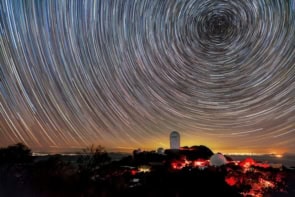
A preprint that uses NASA data to claim “possible evidence” for dark matter has led some researchers to question the US space agency’s data-sharing policies.
The preprint – which was uploaded to the arXiv internet server earlier this month by physicists Lisa Goodenough of New York University and Dan Hooper of Fermilab in Batavia, Illinois – makes the claim by matching a theoretical model of dark matter to freely available data from NASA’s Fermi gamma-ray telescope. But with an official analysis of the same data yet to be published, some scientists have pointed out that, depending on the validity of the evidence, the preprint will either cause confusion or steal glory from the Fermi team.
“If this turns out to be the first convincing discovery, it will become known as the Goodenough and Hooper discovery,” says Alex Murphy, a physicist at the University of Edinburgh who works on Europe’s ZEPLIN III dark-matter experiment. “Publicitywise, that’s a catastrophe.
“You can’t really stop this. NASA has this problem where they have to release their data. I kind of disagree with that myself – I’d hate for our data to be released too early and for others to be looking at it.”
‘Fermi has a PR problem’
The Fermi telescope launched into space in June last year to study the universe’s high-energy phenomena, including the annihilation of dark matter, an unknown entity that many astrophysicists think makes up over 80% of the universe’s mass. Team members used the first year of data to calibrate the telescope’s instruments but now, following NASA policy, they make all data public immediately.
In their study, Goodenough and Hooper examined some of the new Fermi gamma-ray data of the centre of our galaxy. They then compared it with a simple model of dark matter annihilation, which produces gamma rays, and discovered that it fitted a dark matter particle with a mass in the range of 25 to 30 GeV — about 30 times heavier than a proton – and an annihilation cross-section of about 9 × 10–26 cm3/s. According to Hooper, this could indicate a particle such as a neutralino in “supersymmetric” extensions to the Standard Model of particle physics.
Gordon Watts, a physicist at the University of Washington in Seattle, wrote on his blog Life as a Physicist that news coverage of this result on other websites has shown that “things got away” from the Fermi team before they have issued their own analysis. “Now Fermi has a PR problem on its hands – people are running round talking about their data and they’ve [the Fermi team] not really had a voice yet,” he adds.
But Hooper tells physicsworld.com that he sees it as his job to study data as soon as it is released. “Most papers in my community are posted on arXiv prior to being accepted by a journal, and this is no exception,” he says. “This is entirely not out of the ordinary. The reason for this is simply that in the months that it can take for peer review to be carried out, a great deal can change regarding the state of the research, and to not share the up-to-the-minute progress with the rest of the community can be counterproductive.”
Fermi analysis will have ‘lasting impact’
Fermi project scientist Julie McEnery believes her team’s work is not in competition with studies like those of Goodenough and Hooper. “I think a carefully done analysis will have the longer-lasting impact. Had there been an obvious dark-matter signal in the data, something that could be done in a reasonably quick analysis, we would of course have already published – in a refereed journal first, and to [arXiv’s subsection] astro-ph later.”
She adds, however, that all apparently “groundbreaking” results would be better off being published in refereed journals before they appear on arXiv. “There’s a danger that we’re going to confuse the field with many results that prove not to be true, and by the time some really strong, key result comes out essentially the scientific community will still be interested but the media and the public may not be.”
The Fermi team are planning to present their analysis on the galactic-centre data next week. Meanwhile, however, other groups studying the same data have come to different conclusions. For example, in a seperate preprint on arXiv, Gregory Dobler of Harvard University and colleagues attribute the gamma-ray signal to “inverse Compton scattering”, a phenomenon in which photons gain energy when they interact with matter.
“Several groups are doing their own analysis of Fermi data, which I think is fine,” says Katherine Freese, an astrophysicist at the University of Michigan. “The data are public, and there is nothing wrong with people trying to glean from it what they can. In fact, I think it is great. We are all aware that there will be some disagreement in the short term. In the long run it will shake out as to who is right.”



